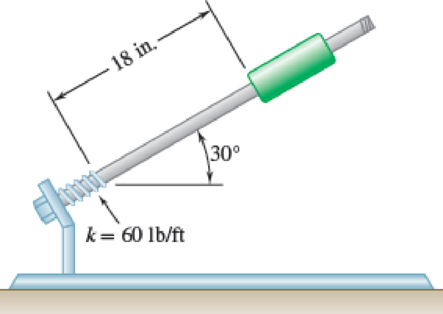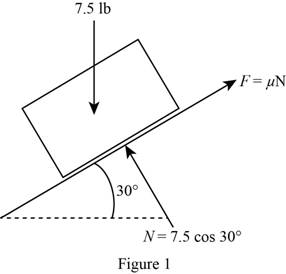
Concept explainers
A 7.5-lb collar is released from rest in the position shown, slides down the inclined rod, and compresses the spring. The direction of motion is reversed and the collar slides up the rod. Knowing that the maximum deflection of the spring is 5 in., determine (a) the coefficient of kinetic friction between the collar and the rod, (b) the maximum speed of the collar.
Fig. P13.29

(a)
Find the coefficient of kinetic friction between the collar and rod
Answer to Problem 13.29P
The coefficient of kinetic friction between the collar and rod
Explanation of Solution
Given information:
The weight of the collar
The maximum deflection of the spring (x) is
The distance between the spring and collar (d) is
The spring constant (k) is
The angle of the inclined rod
Assume the acceleration due to gravity (g) is
Calculation:
Show the free body diagram of the inclined rod with the forces acting as in Figure (1).

Here, the initial kinetic energy
Calculate the work done
Here, F is the frictional force.
Substitute
Substitute
Substitute
Calculate the work done
Substitute
Calculate the work done
Substitute
Calculate the total work done
Substitute
Use work and energy principle which states that kinetic energy of the particle at a displaced point can be obtained by adding the initial kinetic energy and the work done on the particle during its displacement.
Find the coefficient of kinetic friction between the collar and rod
Substitute 0 for
Therefore, the coefficient of kinetic friction between the collar and rod
(b)
Find the maximum speed
Answer to Problem 13.29P
The maximum speed
Explanation of Solution
Given information:
The weight of the collar
The maximum deflection of the spring (x) is
The distance between the spring and collar (d) is
The spring constant (k) is
The angle of the inclined rod
Assume the acceleration due to gravity (g) is
Calculation:
Calculate the kinetic energy
Substitute
Calculate the work done
Here, F is the frictional force.
Substitute
Substitute
Substitute
Calculate the work done
Substitute
Calculate the total work done
Substitute
Substitute 0.159 for
Use work and energy principle which states that kinetic energy of the particle at a displaced point can be obtained by adding the initial kinetic energy and the work done on the particle during its displacement.
Find the maximum speed
Substitute 0 for
Therefore, the maximum speed
Want to see more full solutions like this?
Chapter 13 Solutions
Vector Mechanics for Engineers: Statics and Dynamics
- Two disks sliding on a frictionless horizontal plane with opposite velocities of the same magnitude v0 hit each other squarely. Disk A is known to have a weight of 6 lb and is observed to have zero velocity after impact. Determine (a) the weight of disk B,knowing that the coefficient of restitution between the two disks is 0.5, (b) the range of possible values of the weight of disk B if the coefficient of restitution between the two disks is unknown.arrow_forwardTwo steel blocks slide without friction on a horizontal surface. Their velocities before the impact are shown. Knowing that e = 0.75, determine their velocities after impact.arrow_forwardA 1.5-lb ball that can slide on a horizontal frictionless surface is attached to a fixed point O by means of an elastic cord of constant k= 1 lb/in. and undeformed length 2 ft. The ball is placed at point A, 3 ft from O , and given an initial velocity v0 perpendicular to OA ., allowing the ball to come within a distance d = 9 in. of point O after the cord has become slack. Determine (a) the initial speed v0 of the ball, (b) its maximum speed.arrow_forward
- The coefficient of restitution is 0.9 between the two 60-mm-diameter billiard balls A and B . Ball A is moving in the direction shown with a velocity of 1 m/s when it strikes ball B , which is at rest. Knowing that after impact B is moving in the x direction, determine (a) the angle 0, (b) the velocity of B after impact.arrow_forwardA 600-g ball A is moving with a velocity of magnitude 6 m/s when it is hit as shown by a 1-kg ball B that has a velocity of magnitude 4 m/s. Knowing that the coefficient of restitution is 0.8 and assuming no friction, determine the velocity of each ball after impact.arrow_forwardThree identical small spheres, each weighting 2 lb, can slide freely on a horizontal frictionless surface. Spheres B and C are connected by a light rod and are at rest in the position shown when sphere B is struck squarely by sphere A, which is moving to the right with a velocity v0 = (8 ft/s)i . Knowing that θ = 30° and that the velocities of spheres A and B immediately after the impact are vA = (0.5 ft/s)i and vB = (3.75 ft/s)i + (vB)yj, determine (vB)y and the velocity of C immediately after impact.arrow_forward
- Two identical billiard balls can move freely on a horizontal table. Ball A has a velocity v0 as shown and hits ball B, which is at rest, at a point C defined by 0¸ = 45°. Knowing that the coefficient of restitution between the two balls is e = 0.8 and assuming no friction, determine the velocity of each ball after impact.arrow_forwardA test machine that kicks soccer balls has a 5-lb simulated foot attached to the end of a 6-ft long pendulum arm of negligible mass. Knowing that the arm is released from the horizontal position and that the coefficient of restitution between the foot and the 1-lb ball is 0.8, determine the exit velocity of the ball (a) if the ball is stationary, (b) if the ball is struck when it is rolling towards the foot with a velocity of 10 ft/s.arrow_forwardA 600-g ball A is moving with a velocity of 6 m/s when it is hit as shown by a 1-kg ball B which has a velocity of magnitude 4 m/s. Knowing that the coefficient of restitution is 0.8 and assuming no friction, determine a) the velocity of each ball after impact b) energy lost during the impactarrow_forward
- NEED WITHIN 1HR THANKS 4.A 1.3-lb sphere A is dropped from a height of 1.8 ft onto 2.6-lb plate B, which is supported by a nested set of springs and is initially at rest. Knowing that the set of springs is equivalent to a single spring of constant k = 5 lb/in., determine the value of the coefficient of restitution between the sphere and the plate for which the height h reached by the sphere after rebound is maximum, the corresponding value of h, and the corresponding value of the maximum deflection of the plate.arrow_forwardTwo cars of the same mass run head-on into each other at C. After the collision, the cars skid with their brakes locked and come to a stop in the positions shown in the lower part of the figure. Knowing that the speed of car A just before impact was 5 mi/h and that the coefficient of kinetic friction between the pavement and the tires of both cars is 0.30, determine (a) the speed of car B just before impact, (b) the effective coefficient of restitution between the two cars.arrow_forwardIn a game of pool, ball A is moving with a velocity v0 with a magnitude of v0 = 15 ft/s when it strikes balls B and C , which are at rest and aligned as shown. Knowing that after the collision the three balls move in the directions indicated and assuming frictionless surfaces and perfectly elastic impact (that is, conservation of energy), determine the magnitudes of the velocities vA, vB and vC .arrow_forward
 Elements Of ElectromagneticsMechanical EngineeringISBN:9780190698614Author:Sadiku, Matthew N. O.Publisher:Oxford University Press
Elements Of ElectromagneticsMechanical EngineeringISBN:9780190698614Author:Sadiku, Matthew N. O.Publisher:Oxford University Press Mechanics of Materials (10th Edition)Mechanical EngineeringISBN:9780134319650Author:Russell C. HibbelerPublisher:PEARSON
Mechanics of Materials (10th Edition)Mechanical EngineeringISBN:9780134319650Author:Russell C. HibbelerPublisher:PEARSON Thermodynamics: An Engineering ApproachMechanical EngineeringISBN:9781259822674Author:Yunus A. Cengel Dr., Michael A. BolesPublisher:McGraw-Hill Education
Thermodynamics: An Engineering ApproachMechanical EngineeringISBN:9781259822674Author:Yunus A. Cengel Dr., Michael A. BolesPublisher:McGraw-Hill Education Control Systems EngineeringMechanical EngineeringISBN:9781118170519Author:Norman S. NisePublisher:WILEY
Control Systems EngineeringMechanical EngineeringISBN:9781118170519Author:Norman S. NisePublisher:WILEY Mechanics of Materials (MindTap Course List)Mechanical EngineeringISBN:9781337093347Author:Barry J. Goodno, James M. GerePublisher:Cengage Learning
Mechanics of Materials (MindTap Course List)Mechanical EngineeringISBN:9781337093347Author:Barry J. Goodno, James M. GerePublisher:Cengage Learning Engineering Mechanics: StaticsMechanical EngineeringISBN:9781118807330Author:James L. Meriam, L. G. Kraige, J. N. BoltonPublisher:WILEY
Engineering Mechanics: StaticsMechanical EngineeringISBN:9781118807330Author:James L. Meriam, L. G. Kraige, J. N. BoltonPublisher:WILEY





